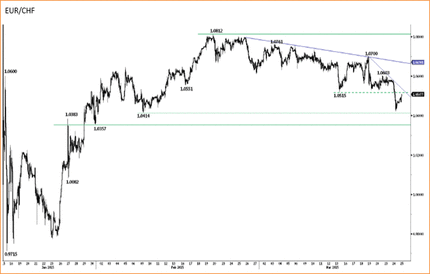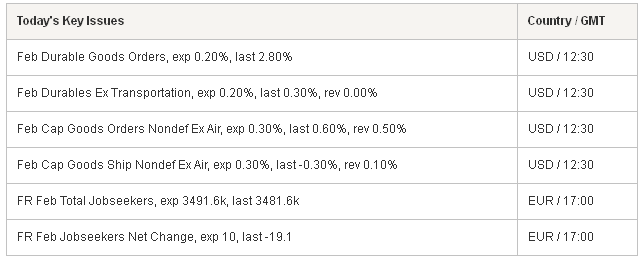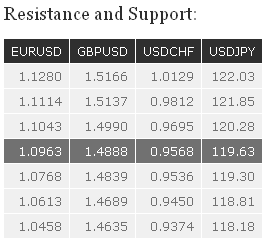Forex News and Events
Swiss franc extend gains as safe heaven inflows push the currency higher against EUR and US Dollar. After trading below 1.05, EUR/CHF struggles to stabilize above this level with increasing suspicions that the SNB might be giving support to today’s recovery. In Japan, the fiscal year end demand in yen caps the upside in JPY-crosses. Friday’s inflation read in Japan should revive concerns that the inflation might deviate from the right direction and trigger fresh JPY sales as the country steps into the new fiscal year.
EUR/CHF struggles to climb back above 1.05
EUR/CHF traded below what the market has accepted as the SNB’s 1.05/1.10 implicit band, despite sustained buying interest in the majority of EUR-crosses. EUR/CHF legged down to 1.04222 yesterday, the break below 1.05 threshold triggered some stress on the euroswiss futures, up to 100.890 for the first time since the SNB refrained to cut rates on March 19th scheduled meeting. EUR/CHF moved back above 1.05 as Europe walked in, with suspicions that the SNB might be back in the game.
The decoupling between EUR/CHF and EUR/USD signals that safe haven flows leads to the actual Swiss franc appreciation, as the bailout talks between Greece and the EU do not finalize. We closely monitor the rate markets in order to keep track of any tension that would signal a potential, unscheduled SNB intervention. Given the global macroeconomic setting, the SNB has room to pull the rates lower in case of emergency. The market should easily absorb 15-25 basis point cut should the EUR risks materialize. (Grexit, Greece insolvability).
The broad franc appreciation pulls USD/CHF down to one-month lows. The pair opened the session below its 100-dma (0.9601) and faces offers above this level. The early formation of an inverted hammer (signaling that the market is looking to determine a bottom) has disappeared following the fresh intraday low at 0.9571 (at the time of writing). This behaviors signals that the actual support (0.9537) is not stable and the appetite on the sell side has not declined sufficiently to reverse the short-term trend. With the Fed walking toward policy normalization (even if the normalization should happen softer than formerly expected), the counter-forces in the US dollar should however curb gains in the franc and challenge the bearish USD/CHF move above pre-200 day moving average (currently at 0.9415).
USD/JPY advance to Ichimoku cloud
The JPY-sales decelerate as the fiscal year end approaches and the seasonal demand in yen, combined to subdued US yields, cap the upside in JPY-crosses. USD/JPY saw support at 50-dma (119.19) yesterday, yet the trend and momentum indicators build marginally bearish. For the fourth consecutive session, we see USD/JPY closing below both the Ichimoku conversion and baseline, paving the way toward the daily cloud cover (118.29/50) should support at 118.81 (100-dma) falls. Option positions are negatively skewed pre-120.00 at today’s expiry.
Japan’s February inflation data is due on Friday. As the household spending contraction is expected to continue for the 11th straight month after the sales taxes were hiked from 5% to 8% on April 2014, the nationwide CPI ex-fresh food (monitored by the BoJ) should have further retreated to 2.1% in February. The BoJ acknowledges that the inflation adjusted from tax effect ranges between 0-0.5% (comfortably below the 2% target) and the lower oil could even push the CPI temporary below zero sometime in the second quarter. If this is the case, the BoJ-doves should power up their bets for more monetary stimulus. Knowing that any attempt on the fiscal leg – Abenomics’ second arrow – wipes away the efforts to revive inflation in the country, we shift our focus to growth and remain cautious vis-à-vis unfounded speculations.
EUR/CHF struggles to move above 1.05


The Risk Today
Luc Luyet
EURUSD
EUR/USD remains strong, indicating a persistent short-term buying interest. However, given the key resistance area between 1.1043 and 1.1114, the upside potential seems limited. Hourly supports can be found at 1.0768 and 1.0613 (19/03/2015 low). In the longer term, the symmetrical triangle favours further weakness towards parity. As a result, any strength is likely to be temporary in nature. Strong resistances stand at 1.1114 (05/03/2015 low) and 1.1534 (03/02/2015 high). Key supports can be found at 1.0504 (21/03/2003 low) and 1.0000 (psychological support).
GBPUSD
GBP/USD has thus far successfully tested the hourly support area around 1.4839 (see also the rising trendline). A decisive break of this zone of support is needed to suggest the end of the current bounce. Another hourly support lies at 1.4689 (19/03/2015 low). A resistance can be found at 1.4990, while a key resistance area stands between 1.5137 and 1.5166. In the longer-term, the break of the strong support at 1.4814 opens the way for further medium-term weakness towards the strong support at 1.4231 (20/05/2010 low). Another strong support stands at 1.3503 (23/01/2009 low). A key resistance can be found at 1.5552 (26/02/2015 high).
USDJPY
USD/JPY has thus far successfully tested the key support at 119.30. A break of the hourly resistance at 120.28 (intraday high) is needed to improve the short-term technical structure. Another resistance stands at 121.20, whereas another support lies at 118.18. A long-term bullish bias is favoured as long as the key support at 115.57 (16/12/2014 low) holds. A gradual rise towards the major resistance at 124.14 (22/06/2007 high) is favoured. A key resistance stands at 121.85 (see also the long-term declining channel).
USDCHF
USD/CHF has broken the key support at 0.9629, opening the way for further short-term weakness towards the support at 0.9450 (see also the 38.2% retracement). Hourly resistances can be found at 0.9695 (24/03/2015 high) and 0.9812 (23/03/2015 high). In the longer-term, the bullish momentum in USD/CHF has resumed after the decline linked to the removal of the EUR/CHF floor. A test of the strong resistance at 1.0240 is likely. A key support can now be found at 0.9374 (20/02/2015 low, see also the 200-day moving average).

